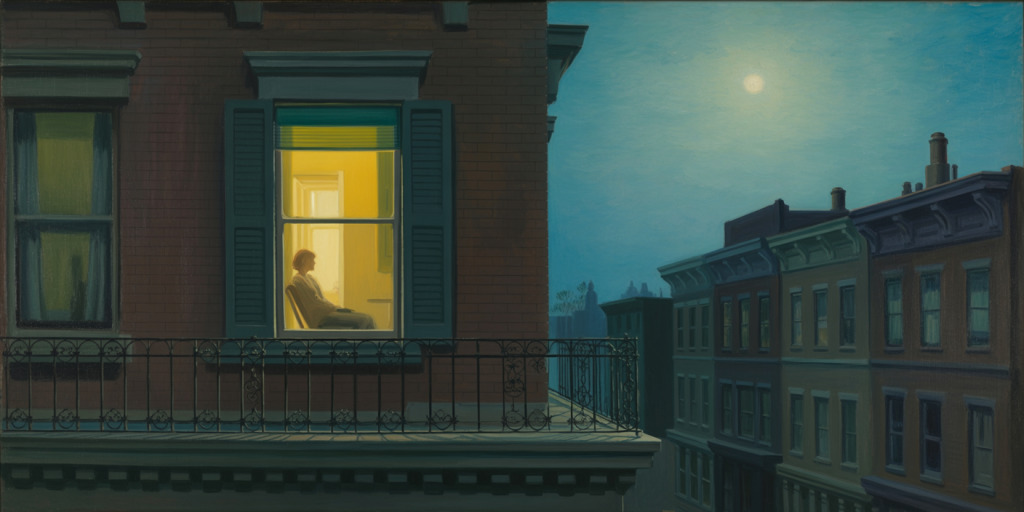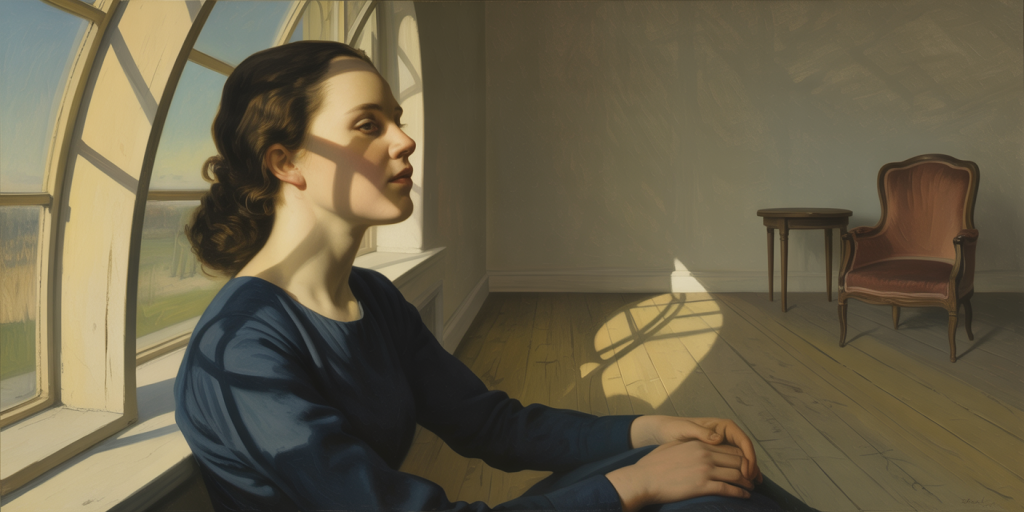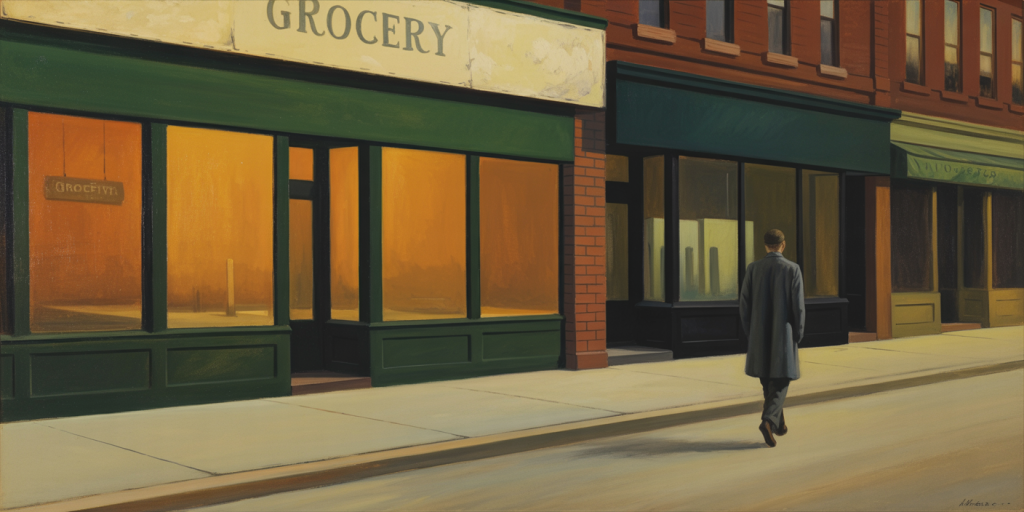Window Lit, World Absent: Hopper’s Urban Poem
A single lit window in the darkness. Not a beacon, but a whisper. A room aglow while the street lies in slumber, while the city holds its breath. In Edward Hopper’s work, solitude is not a lack, but a presence. It expands quietly across painted walls and empty sidewalks, settling like dusk over the body.
Hopper does not paint action. He paints aftermaths, pauses, silences between the notes. His is an urban landscape stripped of motion, yet thick with meaning. A theater after the curtain has fallen. A breath caught just before the cry. In this stillness, we are invited to witness not what is done, but what is felt.
Table of Contents
- Rooms that Remember
- The Lit Window as Heartbeat
- Shadows That Listen
- Stillness Between the Trains
- Flesh and Wallpaper
- The Geometry of Longing
- The Solitary Gaze
- Colors That Refuse to Speak
- Architecture of Isolation
- Light as an Emotion
- The Theater of the Unseen
- Figures Made of Silence
- The Pause Before Memory
- Night as a Mirror
- Reflections on Empty Counters
- Between One Lamp and the Moon
- The Space Behind the Glass
- The City as Introspective Machine
- Letters Never Sent
- Hopper’s Breath in the Canvas
Rooms that Remember
Hopper’s interiors are not merely rooms. They are echoes in paint. Every bedframe and curtain seems to recall the weight of someone who once leaned there, whispered there, wept.
He captures the haunting presence of what is no longer. The furniture feels weary with memory. The walls, though bare, seem to pulse with remembered conversation.
The Lit Window as Heartbeat
A lit window in the darkness is not decoration; it is confession. It pulses in Hopper’s compositions like a heartbeat, a reminder that even within the grid of the city, something personal persists.
The window becomes a soul laid bare, a tender exposure of the life inside, framed in the still geometry of solitude.

Shadows That Listen
In Hopper’s world, shadows are not voids—they are listeners. They do not swallow the figure; they attend it, contour it, hold its presence in quiet reverence.
His shadows are sculptural, patient. They are not merely cast by light, but shaped by emotion. They watch, and in watching, they comfort.
Stillness Between the Trains
The sense of pause in Hopper’s paintings mirrors the stillness between trains, between breaths. Time in his art is not linear—it is circular, suspended.
It feels as though the figures have waited not minutes, but years. The station is not a place of transition, but of delay. In this waiting, meaning accumulates.
Flesh and Wallpaper
Hopper often places the human form against domestic textures: wallpaper, blinds, upholstery. This juxtaposition renders skin more fragile, more seen.
The person becomes part of the decor, yet resists it. There is tension between identity and environment, between motionless form and static pattern.
The Geometry of Longing
His compositions are precise, almost architectural. But within this geometry blooms longing. A lone figure is framed by perpendicular shadows. A door left ajar draws the eye, the heart.
Lines do not merely divide; they yearn. The structure of the scene becomes a map of inner ache.
The Solitary Gaze
Many of Hopper’s figures look not at the viewer, but away—out a window, down at a floor, into a mirror. Their gaze is inward, unrecoverable.
We are voyeurs to their interiority. And yet, we are not unwelcome. Hopper allows us to stand beside them, silently.
Colors That Refuse to Speak
His palette is subdued, almost reluctant. Colors are softened, desaturated, as though hesitant to declare themselves.
Yet in this muteness lies honesty. The greens and ochres, the greys and worn whites, they do not seduce—they confess.
Architecture of Isolation
Hopper’s buildings are often monolithic, silent. They do not reach out; they contain. They are not oppressive, but enclosed.
The solitude they house is not imposed, but chosen. His architecture is emotional before it is structural.
Light as an Emotion
Light in Hopper is not illumination. It is feeling. A square of sun on a bedspread becomes a meditation. A halo of lamp-glow becomes intimacy.
His light is never neutral. It aches. It remembers.

The Theater of the Unseen
Hopper’s paintings are stage sets where the drama happens offscreen. The action is not what we see, but what we imagine just occurred—or is about to.
The narrative is suspended, unsaid. This omission invites projection. We write the script with our own longing.
Figures Made of Silence
His human subjects are defined less by anatomy and more by aura. They are made of silence, of pauses in conversation, of thoughts unfinished.
They do not act. They wait. They absorb. Their presence is not demonstrative, but steady.
The Pause Before Memory
Looking at a Hopper painting feels like standing at the precipice of a memory, just before it becomes clear. There is recognition, but no name.
This suspended familiarity invites introspection. His scenes resonate not because they are specific, but because they are universal in their ambiguity.
Night as a Mirror
Night in Hopper’s hands is not menace, but mirror. The darkness is tender, almost maternal. It enfolds rather than threatens.
Night allows his scenes to glow from within. It erases distractions, sharpening the emotional line.
Reflections on Empty Counters
Diners and shop interiors, so frequent in Hopper’s work, hold the sacred emptiness of places briefly vacated. A counter with no coffee cup. A chair turned slightly askew.
These small absences are louder than presence. They imply life, and in that implication, they haunt.
Between One Lamp and the Moon
Hopper balances the domestic and the celestial. A table lamp burns yellow while the moon gleams silver outside.
This duality creates emotional tension: comfort versus longing, interior warmth versus the cold unknown.
The Space Behind the Glass
Glass is not transparent in Hopper’s world. It is a veil. It separates and reflects. A shop window becomes a mirror to the viewer, a barrier to the figure inside.
Behind glass, intimacy becomes artifact. We witness, but cannot touch.
The City as Introspective Machine
Hopper’s cities do not bustle. They breathe. They are not machines of commerce, but landscapes of introspection.
The urban grid becomes a spiritual map, a structure through which emotion filters and finds corners to rest.

Letters Never Sent
His figures often seem poised to say something, to write, to leave—but they don’t. There is always something unsaid, unfinished.
A letter unsent. A sentence stalled. A movement paused. These absences form the true narrative of Hopper’s work.
Hopper’s Breath in the Canvas
His brushwork is quiet, assured. One can sense the breath between each stroke. Nothing is hurried, everything is weighed.
The texture is neither flamboyant nor invisible. It exists like the skin of the moment—barely noticed, but essential.
FAQ
Who was Edward Hopper?
An American realist painter (1882–1967), Edward Hopper is renowned for his evocative scenes of modern American life, particularly those dealing with solitude, architecture, and introspection.
What is Hopper’s most famous work?
“Nighthawks” (1942) is widely considered his masterpiece, portraying figures in a late-night diner with a haunting stillness that epitomizes his style.
What style did Hopper use?
Hopper worked within the realm of American Realism, but his true style is psychological. He merged technical precision with emotional nuance, creating paintings that feel both literal and lyrical.
Why is solitude so important in his work?
Hopper saw solitude not as a negative space, but as a rich emotional state. His figures are alone, but not always lonely. Their stillness is active, full of interior movement.
Was Hopper influenced by photography or cinema?
Yes, his framing often reflects cinematic composition. He used light, angle, and cropping in ways that resemble stills from a film. This lends his work a narrative quality.
Notes from the Window: Final Reflections
Edward Hopper teaches us to look not at what is loud, but at what is left behind. A lit room. A gaze away. A quiet street where nothing stirs, yet everything feels.
His paintings are not about stories told, but stories waiting. He captures the poetry of the unsaid, the beauty of paused time, the intimacy of being alone but not forgotten.
Through his urban poems in oil and light, Hopper shows that absence is never empty. It is a space filled with echo, memory, and the soft pulse of being.
